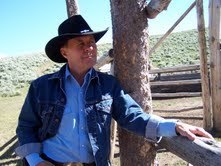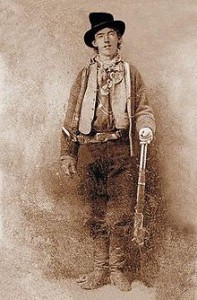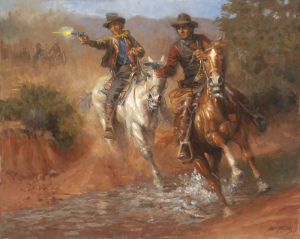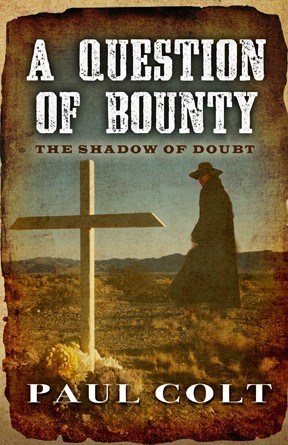A Question of Bounty
Back in October 2012, Paul Colt visited this blog with a post about Pat Garrett and Billy the Kid. Paul’s latest book, A Question of Bounty: The Shadow of Doubt is published this month by Five Star. Here he takes a second look at the death of Billy the Kid.
**********************************************************************

Paul Colt
Two years ago Andi gave me the opportunity to share one of my favorite historical controversies. Pat Garrett claims he killed Billy the Kid, July 14, 1881. John Poe, Garrett’s deputy on the scene that night—and others—question Garrett’s claim. They suggest he killed the wrong man and covered it up.
Today, Garrett’s claim rests on his 1882 book, The Authentic Life of Billy the Kid. The printed word has never been more powerful than it was in the nineteenth century yet it was not always dependable.. Libbie Custer’s idyllic portrayals of her husband George and the legendary treatment given numerous nineteenth century figures all testify to the difference between fact and the cachet of fact.
Garrett’s book remains the accepted historical record of the Kid’s death. What is surprising is that the controversy surrounding his claim also continues to this very day. Why? Because there are contradictions, irregularities, and circumstantial evidence that simply won’t go away. We are left with the question: is Garrett’s claim proven beyond the shadow of doubt, or is it a hastily conceived cover-up?
The controversy piqued my curiosity when I picked up John Poe’s memoir, The Death of Billy the Kid, and laid it beside Garrett’s book. Poe, a respected law enforcement officer and political figure of his time, enjoys a somewhat better reputation than the often financially troubled Garrett. If you take Poe for a credible witness to the events of the Kid’s death, you are left with two differing accounts, procedural irregularities, circumstantial evidence and unanswered questions.
According to both Poe and Garrett, they, along with deputy Kip McKinney, set up a watch for the Kid in an orchard on the edge of Fort Sumner on the night of July 14th. Garrett states that someone resembling the Kid approached Pete Maxwell’s house and he followed him. Poe claims that Garrett entered the Maxwell house to question Maxwell before anyone arrived. By Poe’s account, Garrett left his deputies on watch outside where they were seen by the man who next entered the house. This is significant.
a watch for the Kid in an orchard on the edge of Fort Sumner on the night of July 14th. Garrett states that someone resembling the Kid approached Pete Maxwell’s house and he followed him. Poe claims that Garrett entered the Maxwell house to question Maxwell before anyone arrived. By Poe’s account, Garrett left his deputies on watch outside where they were seen by the man who next entered the house. This is significant.
Imagine you are the Kid, a desperado with a death sentence hanging over your head. Late at night you encounter strangers skulking about your intended destination. Do you go inside to find out who the unknown visitors are; or do you scoot back to your hidey-hole? If you are one of the Kid’s friends in the area, you have no reason to fear the unidentified strangers but your instinct is to warn your friend. You might go inside to find out the stranger’s identity.
As Garrett tells it, the Kid entered Pete Maxwell’s darkened bedroom and asked Maxwell in Spanish the identity of the men outside. Poe’s account agrees with this. But why would the Kid inquire in Spanish? Maxwell spoke English. The Kid spoke Spanish but it wasn’t his first language. On the other hand, the Kid had a goodly number of—obviously Spanish-speaking—Mexican friends in the area. Garrett claims he recognized the Kid’s voice in the dark and shot him. Was it the Kid, or one of his friends?
If the Kid was hiding in the area when the shooting occurred, he could easily have decided that a report of his ‘death’ was better than the pardon he’d sought. Could he have escaped that night and assumed some new identity? It seems a reasonable speculation.
 Garrett and Maxwell took charge of the body and the events that followed. Their actions are tainted by serious irregularities. Maxwell is reported to have written the coroner’s report and the verdict for a coroner’s inquest. The local postmaster signed the inquest verdict as foreman the following morning. The jurors never met as a group. The Justice of the Peace, who allegedly impaneled the jury, made no official record of it. The coroner’s report and inquest verdict were entrusted to Garrett to file at the Lincoln County Courthouse. Neither document has ever been found. Is it possible Garrett ‘lost’ documents he feared wouldn’t stand up to close scrutiny? A facsimile of what appears to be the inquest verdict was discovered decades later. Misspellings and the use of ‘marks’ witnessed by Pete Maxwell suggest that some of the jurors’ signatures may have been falsified. Then there is the facsimile. The technology wasn’t invented until decades later. If a photocopy was made of the original, what happened to that document? Could the original have been a forgery disguised by facsimile to prove the Garrett claim?
Garrett and Maxwell took charge of the body and the events that followed. Their actions are tainted by serious irregularities. Maxwell is reported to have written the coroner’s report and the verdict for a coroner’s inquest. The local postmaster signed the inquest verdict as foreman the following morning. The jurors never met as a group. The Justice of the Peace, who allegedly impaneled the jury, made no official record of it. The coroner’s report and inquest verdict were entrusted to Garrett to file at the Lincoln County Courthouse. Neither document has ever been found. Is it possible Garrett ‘lost’ documents he feared wouldn’t stand up to close scrutiny? A facsimile of what appears to be the inquest verdict was discovered decades later. Misspellings and the use of ‘marks’ witnessed by Pete Maxwell suggest that some of the jurors’ signatures may have been falsified. Then there is the facsimile. The technology wasn’t invented until decades later. If a photocopy was made of the original, what happened to that document? Could the original have been a forgery disguised by facsimile to prove the Garrett claim?
The body was buried the following morning. It was not publicly displayed as was the custom with high profile outlaws. No photos were taken of the body or Garrett with the body as was also the custom. All this favors the appearance of a cover up.
If Garrett killed the wrong man, he obviously had motive enough for a cover up. That begs the question why would Pete Maxwell help him? History tells us that the Kid was romantically involved with Pete’s younger sister, Paulita. Maxwell’s motive for participating in a cover-up might have been to get the Kid out of Paulita’s life once and for all.
There are those who vigorously defend Garrett’s account of the Kid’s death. The publication itself seems self-serving. The printed word firmly established Garrett’s claim to have killed the Kid. In the book, he suggests Poe and McKinney questioned the identity of the victim at the time of the shooting. He then goes on to refute the allegation. According to Poe, he initially supported Garrett; his doubts came later. Garrett’s book seems a convenient response to those suspicions.
Did Pat Garrett kill Billy the Kid? Historians are convinced. They have Pat Garrett’s word on it. The state of New Mexico is convinced. They’ve got an iconic legend and the tourist attractions that go with it. One hundred thirty years later questions remain. And leads to the ultimate question: if Garrett didn’t kill the Kid, what happened to him? Did he simply ride off ?
Two years ago I said I’d written a book based on Poe’s memoir. The story I call A Question of Bounty: The Shadow of Doubt speculates about what might have happened to the Kid if he did indeed walk away that night. The story focuses on a mysterious character, resembling the Kid, who appears out of nowhere mere weeks after the Kid’s alleged death. He lives a quiet life, never claiming to be the Kid and dies of natural causes years later. Admittedly his story is based on circumstantial evidence and hearsay. When I finished, I concluded that the controversy is one man’s word against that of another. Both cases are circumstantial. Neither case can be proven beyond the shadow of doubt.
Five Star Publishing will release A Question of Bounty: The Shadow of Doubt this  month. If you’re curious about what makes a controversy last one hundred and thirty years, I think you’ll find this one entertaining. In the end, you decide.
month. If you’re curious about what makes a controversy last one hundred and thirty years, I think you’ll find this one entertaining. In the end, you decide.
Enjoy the ride.
Paul Colt
***************************
Paul has very kindly agreed to give away a signed paper copy of A Question of Bounty to one person leaving an interesting comment. The winner will be announced here on or about the 23rd June.
‘Award winning author Paul Colt follows Billy the Kid’s outlaw adventures and unlikely young love affair to that fateful encounter with Sheriff Pat Garrett in Pete Maxwell’s bedroom. Colt gives the reader insight into the Kid’s life with richly visual settings and believable characters.’





